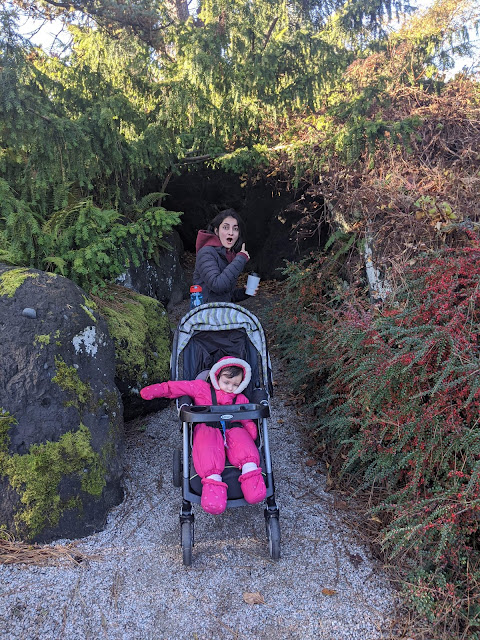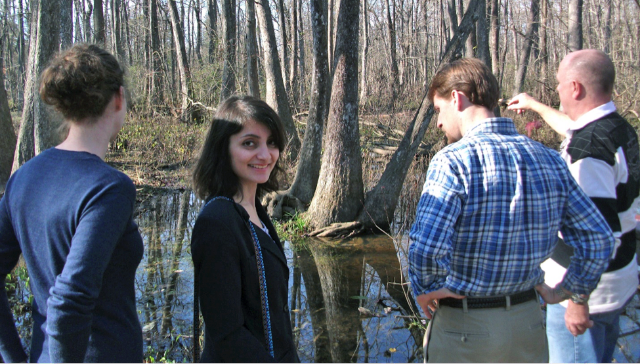VanDusen Botanical Gardens
One of best paid attractions to see in Vancouver proper is the VanDusen Botanical Gardens, a 55-acre well-curated garden smack in the middle of the city. It is also one of the few gardens that has a beautiful café and restaurant on sight, lots of entertaining botanical collections, totems and sculptures, a maze, a pagoda and great Feng Shui generally. Plus all for a mere $8.
It was the start of November when my daughter, husband and myself, visited the Gardens. It was a cold but sunny day, a perfect day to enjoy Vancouver fall. While it might not have been the best time to see the flowers, the fall leaves were equally glorious and there was still plenty of life in the trees. The gardens reminded me of a lot of the parks I had visited in Korea given the number of conveniences on sight, as well as a really well-maintained.
Due to COVID-19, tickets were only available online, and you can quickly get these scanned at the Visitor Centre, which in itself is quite a sight. Named the Most Sustainable Building of the Year in 2014, the center is shaped like an orchid when viewed from above and was designed by Perkins & Will Architects.
The Garden was once part of a gold course known as the Shaughnessy Golf Course but was saved in the 1960s from commercial development by a determined group of citizens called the Vancouver Public Gardens Association (VPGA). A fundraising effort, spearheaded by a $1 million donation from the timber magnate and philanthropist Whitford Julian VanDusen (one-third of the capital cost of creating the garden at the time), culminated with the official opening in August 1975. Though Mr. VanDusen had to be persuaded to permit it, the garden honours him in its name.

The Elizabethan Maze
There is a maze within the Gardens, which appears to be very unassuming from the outside, but once you enter it, it is easy to get lost. Made of 3,000 pyramidal cedars, the maze is fairly narrow but difficult to get out of.

Stone Garden
When we arrived here, we were really confused what this was, and thought it might be some Confucian stuff. This area has a landscape stylized on an oriental theme, with vertical outcroppings of rock that symbolize “islands” in a dry lake. There is a practical reason for this design, because the site is the roof of the abandoned Point Grey reservoir. Lightweight volcanic rock is used, as the weight factor has to be considered. The area adjacent to the Stone Garden is the second highest point in Vancouver, the highest being Little Mountain in Queen Elizabeth Park.
Scottish Shelter
Though the shelter was closed due to COVID, it was viewable. The shelter was essentially a structure in the Heather Garden built of local basaltic rock in a style compatible with the moorland theme of the surrounding landscape. Originally such a structure would have had a thatched roof of heather, but for reasons of safety and ease of maintenance, natural slate is used instead.
Korean Pavilion
This wasn't too unique since we've seen these pavilion in every nook and cranny in Korea. However, this hexagonal pavilion was a gift from the Korean people in 1986, at the conclusion of the World Exposition in Vancouver. The plants around it were all from the orient, and pretty much the entire area in this part of the Gardens had plants native to Asia.
Rhododendron Walk
To be honest, we didn't get to see the rhododendrums because it was the fall, but they are all the rave in the Gardens. More than 600 species and dozens of hybrids are planted in the Gardens and bloom in Spring, and some cultivars are more than 140 years old.
Rose garden
This is one part I really want to revisit in the Spring, because none of the roses were in bloom and yet the plants were there and the entire classical, formal symmetrical layout with short boxwood parterres and sundial was gorgeous. Perfect photo-opp spot FYI.

We saw a number of lakes and waterbodies scattered about. Cypress Pond is especially popular for its floating bridge.



This looked like a meadow. A broad selection of herbaceous perennials planted in loose associations gives this garden its relaxed meadow-like appearance.
Perennial border
Backed by a neatly clipped yew hedge, this curving perennial border is one of the highlights of the garden and faces excellent examples of islands perennial beds.
Great lawn
This open and broad expanse of lawn has been the site of many popular events and concerts and is the still, calm centre in the middle of the garden, a popular place for picnics in summer.
Canadian Heritage Garden
Examples of heritage fruit trees provide early pollen for bees in nearby hives. The garden also features indigenous Canadian plants as well as species used as medicinal plants by first nations people.







0 comments